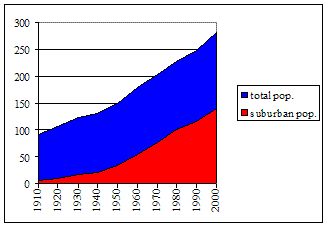« service instead of politics? blame Clinton | Main | who's more powerful, Bill Gates or Kim Jong-il? »
February 21, 2005
the aesthetics of suburbs

But the fear of being charged with snobbery should not prevent us from grappling with aesthetic problems. The beauty (or ugliness) of our environment is important. And I maintain that suburbs are ugly, especially if one considers their relative affluence. A retail strip in Bethesda, MD may be more attractive than many blighted streets in the Southeast quadrant of Washington, DC. But residents of Bethesda occupy homes with a median market value of $396,000 (in 2000). Their median household income was above $99,000 that year. Compared to urbanites of the same wealth, they live in ugly surroundings. Strip malls are uglier than shopping streets. Suburban office parks are uglier than contiguous office buildings. Clusters of wires are uglier than buried ones. On-ramps are uglier than urban intersections. Ranch houses tend to be uglier than row houses. I think huge lawns are uglier than front yards. Big revolving signs for fast food restaurants are certainly uglier than shop fronts.
It’s important to recognize that the suburban landscape is very recent. More than 100 million people had to be housed in new communities in the space of 50 years. Maybe these encampments will look better once we have settled in. Maybe we’ll figure out ways to improve the look of the familiar combination of a wide road, grassy strip, parking lot, and cement-block store. Higher density may improve aesthetics, simply because all that wasted—cleared but vacant—land in the suburbs is ugly.
But we’ll have to overcome another kind of problem, too: a dynamic that discourages investment in suburban public spaces. In cities, private owners have motives to invest in the public appearance of their property: a shop-window, a façade, or a lobby can be an efficient advertisement. Banks, hotels, and department stores are often major civic ornaments, constructed at private expense; but even traditional tenement houses had handsome cornices. The worst buildings in cities are often public ones: for example, housing “projects” constructed by cheap authorities for the poorest residents.
In contrast, there is profound underinvestment in the outward appearance of suburban buildings. Even a fancy office park will often show basically blank walls to the outside. It is designed for the people in the offices. Visitors come by car and don’t need to be drawn in or impressed by the façade. There are expensive suburban restaurants with “designer” interiors that sit in completely undistinguished parking lots. The new arts center in Bethesda has received positive reviews for its glamorous architecture; but you can’t see the building from the nearby main road that carries probably 2,000 vehicles/hour at its peak. For all those “passers-by,” the architecture means nothing.
I suspect that this underinvestment is partly a function of low density. It usually doesn’t pay in a suburb to use architecture and landscaping as advertisements—especially when people zoom past in cars. Another cause of the problem may be rapid growth. If everything around your building looks ugly and temporary, then it doesn’t pay to try to improve the landscape by investing in the small piece of it that you own. Third, suburbs compete madly for new construction, and they can’t regulate aesthetics without simply losing development to the next jurisdiction. Finally, it may be individualism that explains both the migration to the “crabgrass frontier” and the failure, once there, to invest in public spaces.
February 21, 2005 7:59 AM | category: none